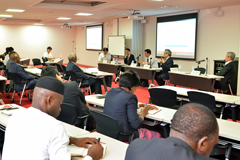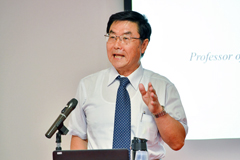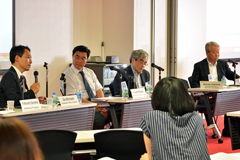Deeper Discussions on the TIF Strategy for the Industrial Development of Sub-Saharan Africa
2018.08.08
On July 23, 2018, the National Graduate Institute for Policy Studies (GRIPS) and the JICA Research Institute (JICA-RI) jointly held a workshop to discuss strategy for the industrial development of Sub-Saharan Africa.
The purpose of this workshop was to further improve upon the “Training-Infrastructure-Finance (TIF) Strategy” report that was published by the Research Group on Strategic Support for Industrial Development in Sub-Saharan Africa in November 2017. Many officials from African embassies in Japan were invited in particular, and an exchange of views took place.

The workshop brought together many officials from African embassies in Japan
The TIF strategy proposes assistance designed around the TIF sequence — first human resource Training, then Infrastructure development, and lastly Finance — along with the need to promote foreign direct investment in accordance with that process. In concrete terms, the methodology for human resource training targets management and workers simultaneously, and the adoption of Kaizen (continuous improvement) to increase productivity in an inexpensive manner is recommended.
Following the opening remarks by GRIPS Vice President Tetsushi Sonobe, Kobe University’s Keijiro Otsuka, one of the contributors to the TIF strategy report, delivered the keynote speech. On stage during the panel discussion that followed were GRIPS President Akihiko Tanaka, a JICA Research Institute distinguished fellow and former JICA president; JICA Senior Vice President Hiroshi Kato; and JICA-RI Visiting Scholar Go Shimada, associate professor at Meiji University.
Otsuka began by introducing two types of industrial clusters: survival clusters and dynamic clusters. Under the survival cluster, which is common in Africa, even if a company launches a new and promising business, prices decrease and profits to fall due to an increase of newcomers in the market. Under the dynamic cluster, the model typically seen in Asia, a decline in prices and profit provides motivation for companies to innovate, which makes possible an increase in quality as well as greater profits. Otsuka spoke of the need for innovation in order to achieve sustainable growth.

Kobe University's Keijiro Otsuka said the key to multifaceted innovation is training
He went on to explain that the key to multifaceted innovation is training. In particular, the development of East Asia has depended on learning from abroad, and Otsuka expressed the view that Sub-Saharan Africa has generally put little effort into this area. Using the garment industry in Bangladesh as an example, he noted that in 1979, there were essentially no garment companies in the country, but today, the number has grown to 5,000 companies in an enormous industry where each company on average employs 700 people. One factor in this growth is the training that took place in South Korea, Singapore, and Japan — in other words, internationally — and he emphasized the importance of training provided by governments and international organizations. Additionally, Otsuka pointed out that gradual Kaizen led by a low-cost, bottom-up approach would be the factor driving innovation and promoting the shift from survival clusters to dynamic clusters.
In the following panel discussion, Shimada touched on the essential role that nongovernmental economic organizations, such as the Japan Committee for Economic Development, played in Japan’s post-war economic growth, particularly concerning the introduction of the Kaizen principle. He then raised the question on how TIF should be promoted with respect to the upcoming Tokyo International Conference on African Development (TICAD) in order to support African businesses. Otsuka answered that TIF should be promoted by appealing to government leaders, providing successful case studies, and hosting seminars and other events in various countries.

On stage during the panel discussion from left are JICA-RI Visiting Scholar Go Shimada, Professor Keijiro Otsuka, JICA Senior Vice President Hiroshi Kato and GRIPS President Akihiko Tanaka
Next, Kato stated that African countries need to utilize the industries they already have, and he praised in particular the importance TIF places on a holistic and sequential approach that includes not only technical training, but management skills as well. He also pointed out that in order for Japan’s private sector to be more active in Africa, it is important to find local business partners that can be relied upon.
Lastly, Tanaka expressed his appreciation for the value this research has had, both managing academic achievement and providing concrete public policy proposals. On the academic side, Tanaka praised the fact that joint research has demonstrated that there are many hidden industrial clusters in sub-Sahara Africa, whereas many development economists had assumed there was no significant number of industrial clusters in Africa. He also praised the research’s proposal that management is the key to innovation. At the same time, he pointed out that advancing from the training stage to the ensuing infrastructure development stage would require brainstorming on what kind of industries would need to be developed in industrial park.
During the question-and-answer session, an audience member from the South African embassy asked what has been the most effective support Japan has provided for industrial development so far. In response, Otsuka and Shimada pointed out the effectiveness of Kaizen in Africa and the countries of Central America and the Caribbean. Another audience member from the Ugandan embassy asked how we can form partnerships with Japanese small- and medium-sized companies. Kato replied that digging up potential local partner companies requires trial and error but we may be able to figure out how with the cooperation of public organizations, such as JETRO and JICA. From the various comments that were made, the workshop uncovered the issues that must be dealt with.

事業事前評価表(地球規模課題対応国際科学技術協力(SATREPS)).国際協力機構 地球環境部 . 防災第一チーム. 1.案件名.国 名: フィリピン共和国.

事業事前評価表(地球規模課題対応国際科学技術協力(SATREPS)).国際協力機構 地球環境部 . 防災第一チーム. 1.案件名.国 名: フィリピン共和国.

事業事前評価表(地球規模課題対応国際科学技術協力(SATREPS)).国際協力機構 地球環境部 . 防災第一チーム. 1.案件名.国 名: フィリピン共和国.

事業事前評価表(地球規模課題対応国際科学技術協力(SATREPS)).国際協力機構 地球環境部 . 防災第一チーム. 1.案件名.国 名: フィリピン共和国.

事業事前評価表(地球規模課題対応国際科学技術協力(SATREPS)).国際協力機構 地球環境部 . 防災第一チーム. 1.案件名.国 名: フィリピン共和国.
scroll